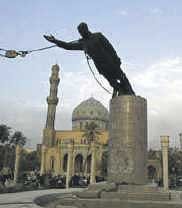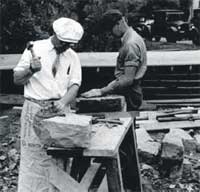
People danced in the streets. Laughing and dancing while musicians played. Three decades had passed with no music or public gathering. There had been government rallies with military bands. Functions when attendance was required. But, today belonged to the people. The tyrant was ousted, the country liberated.
As of one mind, the assemblage flowed toward the town square. One last thing must be done. A golden bronze statue, four times the size of life, dominates the square. Dominates the town. Dominates the people. The casting portrays the benevolent leader, right arm raised as if asking for divine guidance. The lie is completed with a fatherly smile under a drooping mustache and bushy brows. The truth is seen in the eyes, the military garb, beret, and sidearm.

The people rejoiced ...
for a whileRopes snaked from the crowd. Two encircled the upthrusted arm. Three ensnared the throat. Men heaved on the lines. The statue wavered but did not topple. The crowd chanted as they pulled in unison. Still the statue stayed, mocking the people with its smile. In frustrated frenzy, men and women savagely tugged the ropes; beat on the bronze with fists and sticks. Two young boys clambered up the monument in a vain attempt to break off the skyward pointing arm.
An officer of the liberating force dispatched an armored vehicle, well aware of the symbolism and propaganda value. The heavy war machine was put in place, the ropes attached to its turret. Slowly, the behemoth backed away. The lines strained, then snapped. The statue remained standing. A chain was lashed to the casting’s midsection.
The steel monster moved back to the statue. This time the sculpture would be brought down. With chain hooked, the tracks of the tank dug in. The statue leaned, then broke below its knees. A roar erupted from the crowd. The fallen statue was seized and joyously dragged through the streets, away from the square.

Stone Cutters at workTwo men remained in the now empty and quiet square. They were old men. Their weathered faces, sinewy forearms, and bowed backs attested to a life of hard work. These men were skilled workers in stone. They were born to a trade passed down through the generations. They themselves had passed the art to their sons.
The old men walked to where the statue had stood. They examined the pedestal. This was their interest. Not what was, but what is. They traced the expertly fitted joints with gnarled fingers. The stone had been judged by eye, shaped by hammer. The casting had to be integrated with the stone in a way not to disrupt the artist’s intent. The craftsmanship by which the statue had stood these many years and the way it had fell, paid tribute to the artisans.
The men studied the remains of the casting, the integrity of the pedestal, nodding approval. They moved off. In a different direction from the crowd.